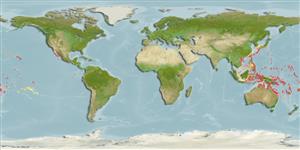>
Blenniiformes (Blennies) >
Blenniidae (Combtooth blennies) > Salariinae
Etymology: Crossosalarias: Greek krossoi = tassel + Latin, salar, salaris = trout (Ref. 45335).
Environment: milieu / climate zone / profondeur / distribution range
Écologie
marin récifal; profondeur 1 - 25 m (Ref. 9710), usually ? - 10 m (Ref. 9710). Tropical
Western Pacific: east to Tonga.
Taille / Poids / Âge
Maturité: Lm ? range ? - ? cm
Max length : 10.0 cm TL mâle / non sexé; (Ref. 9710)
Description synthétique
Clés d'identification | Morphologie | Morphométrie
Épines dorsales (Total) : 12; Rayons mous dorsaux (Total) : 16 - 18; Épines anales: 2; Rayons mous anaux: 18 - 20. Dorsal fin spines elongate, extending beyond membrane. Terminal anal ray connected by membrane to caudal peduncle. Gill opening narrow and restricted, slightly below the level of the ventralmost pectoral ray. Some preopercular and mandibular pores with cirri. A black, fleshy flap at the base of the 1st dorsal spine. A black blotch is present ventrally on each side of the head.
Body shape (shape guide): elongated; Cross section: circular.
Adults are found in seaward reefs (Ref. 9710). Also inhabit shallow, semi-exposed, hard-coral and rock reef with rich algae growth (Ref. 48636). Oviparous. Eggs are demersal and adhesive (Ref. 205), and are attached to the substrate via a filamentous, adhesive pad or pedestal (Ref. 94114). Larvae are planktonic, often found in shallow, coastal waters (Ref. 94114).
Life cycle and mating behavior
Maturité | Reproduction | Frai | Œufs | Fécondité | Larves
Oviparous, distinct pairing (Ref. 205).
Randall, J.E., G.R. Allen and R.C. Steene, 1990. Fishes of the Great Barrier Reef and Coral Sea. University of Hawaii Press, Honolulu, Hawaii. 506 p. (Ref. 2334)
Statut dans la liste rouge de l'IUCN (Ref. 130435: Version 2025-1)
Menace pour l'homme
Harmless
Utilisations par l'homme
Outils
Articles particuliers
Télécharger en XML
Sources Internet
Estimates based on models
Preferred temperature (Réf.
123201): 24.6 - 29.3, mean 28.5 °C (based on 1754 cells).
Phylogenetic diversity index (Réf.
82804): PD
50 = 1.0000 [Uniqueness, from 0.5 = low to 2.0 = high].
Bayesian length-weight: a=0.00776 (0.00356 - 0.01695), b=3.00 (2.81 - 3.19), in cm total length, based on LWR estimates for this (Sub)family-body shape (Ref.
93245).
Résilience (Réf.
120179): Haut, temps minimum de doublement de population inférieur à 15 mois (Preliminary K or Fecundity.).
Fishing Vulnerability (Ref.
59153): Low vulnerability (10 of 100).
🛈
Nutrients (Ref.
124155): Calcium = 146 [73, 228] mg/100g; Iron = 0.797 [0.477, 1.313] mg/100g; Protein = 18.2 [17.1, 19.2] %; Omega3 = 0.0963 [, ] g/100g; Selenium = 25.1 [12.4, 51.6] μg/100g; VitaminA = 128 [40, 403] μg/100g; Zinc = 2.15 [1.47, 3.02] mg/100g (wet weight);
